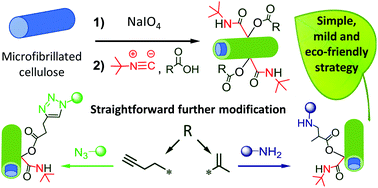Résumé:
« Through a cascade of chemical derivatizations involving the green Passerini three-component reaction
(P-3CR), we describe herein the multifunctionnalization of cellulose microfibrils (MFC) previously subjected
to a periodate oxidation step. Not only do MFC constitute a remarkably attractive cellulose substrate
from industrial and fundamental standpoints, but their periodate oxidation increases their reactivity
while keeping their unique attributes. The Passerini reaction allowed for the successful grafting of two
judiciously chosen chemical precursors in aqueous one-pot heterogeneous conditions, thus leading to
the generation of dually modified (both functional and reactive) MFCs. Namely, as a proof of concept of
this strategy, a tert-butyl isocyanide and a carboxylic acid, the latter bearing either an alkyne or a methacrylate
function, were reacted with the aldehyde moieties present at the surface of periodate oxidized
cellulose (POC). A thorough characterization evidenced the success of the double functionnalization,
provided the degrees of substitution (DS) and allowed for elucidating the impact of structural (i.e. degree
of oxidation of POC, nature of the acid partner) and experimental (i.e. amount of reagent) parameters on
the P-3CR yield. Finally, the reactive Passerini-modified MFCs were conveniently post-derivatized by
appealing aqueous coupling ligations. Specifically, MFC decorated with methacrylate functions were
reacted with an amine through the aza-Michael reaction, while the propensity of alkyne-functionalized
MFC to react through copper catalyzed Huisgen cycloaddition was demonstrated by grafting two
different azides. This P-3CR chemical strategy exhibiting good atom economy appears as a mild, versatile,
and eco-friendly synthetic approach for the dual surface modification of MFCs. Furthermore, the facility
to post-modify such reactive Passerini-modified MFC objects through various popular ligation reactions
paves the way to the straightforward generation of a large panel of tailor-made MFC objects in an
aqueous process, whose surface properties can be suitably adjusted to the targeted application by the
right choice of the two precursors engaged in P-3CRs. »
L’article est disponible ici: https://pubs.rsc.org/en/content/articlelanding/2020/gc/d0gc02532a#!divAbstract

